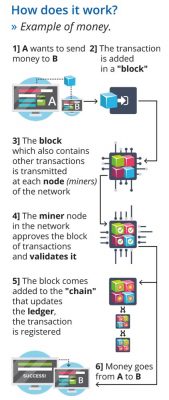In recent years, blockchain technology has gained significant attention, often in connection with cryptocurrencies. However, this innovative system has the potential to revolutionize energy management in the near future.
Blockchain systems: definition
Blockchain is a technology designed for recording and validating transactions of various types—for instance, financial transactions, as seen with Bitcoin.
To better understand how it works, blockchain is often compared to a general leadger that stores all transactions. This ledger is fragmented and replicated across multiple nodes within a network. Each node independently saves, updates, and replicates the database. When a new transaction occurs, it is added as a “block” to the existing chain of transactions, which then undergoes a validation process.
This validation is typically carried out by specialized nodes called miners. Miners solve highly complex mathematical algorithms, and the first node to successfully complete the algorithm earns the right to validate the block of transactions.
Key features of a blockchain:
- reliability: this system is secure against external attacks thanks to the multiple nodes that hold information about transactions, particularly in a public network
- integrity: once information is added to the network, it cannot be altered
- transparency: transactions and information are visible to all nodes (even if encrypted)
- irrevocability of operations: approved transactions cannot be canceled or modified. Each transaction is precisely recorded with a specific timestamp.
- convenience: no third parties are involved to guarantee or approve transactions, reducing costs.
Public blockchains
In public blockchains, anyone can access the network, make transactions or create and verify new blocks.
This structure is completely decentralized and there is no entity that controls the access authorizations but all the functions are assigned to the various nodes equally.
Potential applications of Blockchain Technology
Blockchain technology has a wide range of potential applications and is being tested in fields such as banking, education, insurance, commercial contracts, payments, financial transactions, and, notably, the energy sector.
How can blockchain technology revolutionize the world of energy?
The rise of distributed energy generation, storage systems, and electric mobility has created an increasing demand for energy exchange within an “energy-sharing” framework. This approach envisions energy transactions occurring without intermediaries, allowing freedom in timing and execution.
A blockchain-based structure can make this vision a reality. With blockchain, every user could be able to choose between:
- exchanging their energy with their neighbours
- consume only “clean” energy
- receive money or compensate with that amount
A blockchain could also simplify the creation of microgrid services, thanks to smart meters that:
- guarantee real-timee energy monitoring, avoiding double counting (applying a time stamp to each transaction before adding it to a block)
- integrate with big data structures in order too enable fast, highly detailed transactions for all participating users
However, all microgrid transactions would be processed automatically, transparently and on time. Microgrid pilot projects have been launched in New York, Australia and Germany.
To maintain a good level of privacy in the network, the data is protected by cryptography so that nobody sees the data that does not belong to them.







